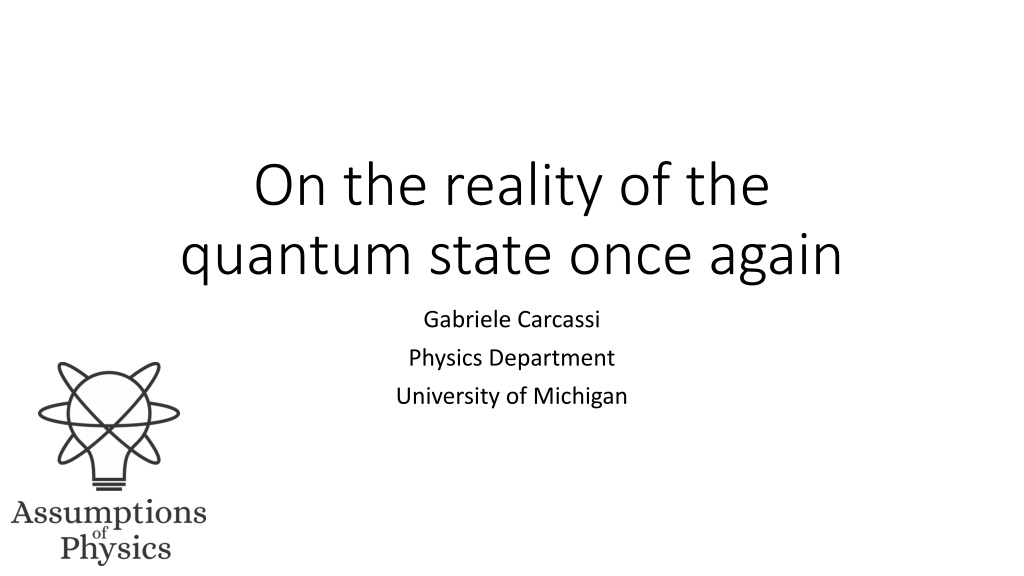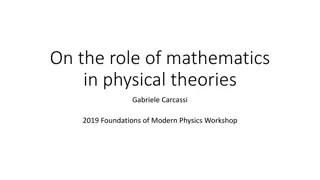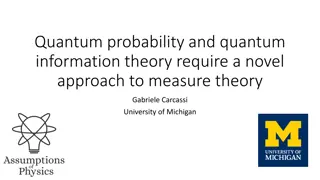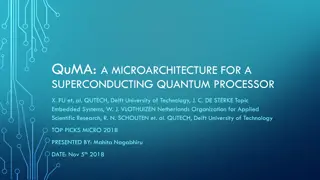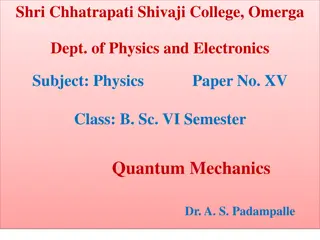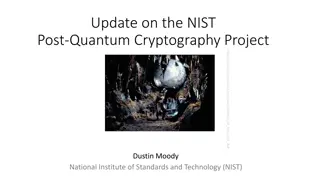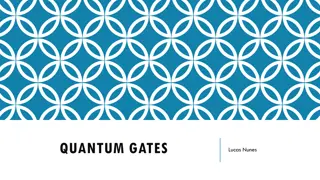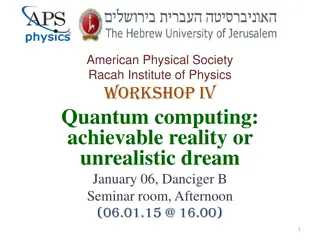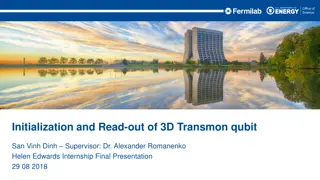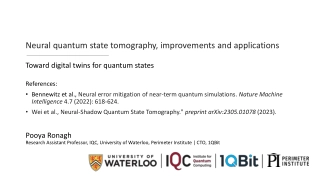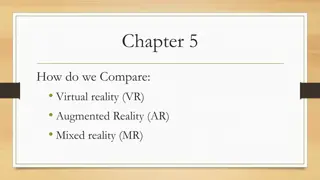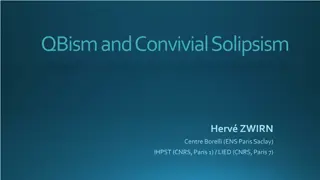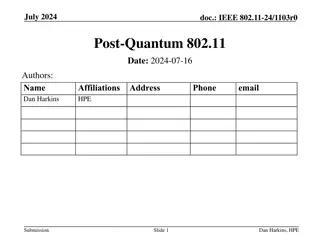Exploring Quantum State Reality by Gabriele Carcassi at University of Michigan
Gabriele Carcassi from the Physics Department at the University of Michigan delves into the intricacies of quantum state reality, challenging ontic models' compatibility with quantum mechanics and the limitations of measure theory in reproducing quantum probability and information theory.
Download Presentation

Please find below an Image/Link to download the presentation.
The content on the website is provided AS IS for your information and personal use only. It may not be sold, licensed, or shared on other websites without obtaining consent from the author. Download presentation by click this link. If you encounter any issues during the download, it is possible that the publisher has removed the file from their server.
E N D
Presentation Transcript
On the reality of the quantum state once again Gabriele Carcassi Physics Department University of Michigan
The paper On the reality of the quantum state once again Gabriele Carcassi, Andrea Oldofredi, Christine A. Aidala Under review Gabriele Carcassi Christine A. Aidala Andrea Oldofredi University of Michigan University of Lisbon Gabriele Carcassi - Physics Department - University of Michigan 2
Thesis ?-ontic models are not compatible with quantum mechanics Combined with PBR Harrigan-Spekkens categorization is essentially empty More in general: measure theory cannot reproduce quantum probability and quantum information theory Gabriele Carcassi - Physics Department - University of Michigan 3
Plan Ontological model review Ontological vs epistemic states, implicit use of standard (Kolmogorov) probability, PBR rules out epistemic models (w/ independent preparation) ?-ontic models violate quantum information theory Epistemic states and quantum mixed states form a real vector space partially ordered by information entropy (which quantifies the epistemic content), the linear map between them is not an order isomorphism (cannot map the epistemic content in any meaningful way) Failure of classical measure theory and quantum contextuality Counting is different in measure theory and quantum mechanics (i.e. 1 + 1 2), quantum contextuality is linked to this difference Gabriele Carcassi - Physics Department - University of Michigan 4
Disclaimer We are not going to talk about specific interpretations ONLY about Harrigan-Spekkens categorization We are not going to talk about epistemic and ontological models in general ONLY the narrow definition given by the Harrigan-Spekkens categorization We are not going to talk about the philosophical implications ONLY the mathematical and physical implications Gabriele Carcassi - Physics Department - University of Michigan 5
Ontological model review Gabriele Carcassi - Physics Department - University of Michigan 6
Start with the operational settings for Quantum Mechanics Preparation protocol ? Density operator ? Measurement protocol ? Measurement values ? POVM ?? ? ? ?,? = tr ??? Ontological model puts an intermediate step Ontological states ?? ? ? ?,? ?(?|?) = tr ??? Epistemic state Gabriele Carcassi - Physics Department - University of Michigan 7
Epistemic states mix according to standard (Kolmogorov) rules Mixture of pure states ?? with probabilities ?? ?(?|?) = ??? ? ??? ? Each ontological model is therefore characterized simply by the epistemic states that correspond to pure states We will gloss over some technical imprecisions (e.g. probability and probability densities are different objects) Gabriele Carcassi - Physics Department - University of Michigan 8
Classify models based on ? ? ??? Epistemic models Ontological models ? ? ?? ? ? ?? ? ? ?? ? ? ?? ? ? No overlap: ontological state retains information about preparation Can overlap: same ontological state can be prepared in different ways PBR claims these are ruled out (w/ independent preparation) Complete if ? ???? = 1 for all ? What about these? Gabriele Carcassi - Physics Department - University of Michigan 9
?-ontic models violate quantum information theory Gabriele Carcassi - Physics Department - University of Michigan 10
1 ? ? = ? ? Standard probability ? ? Measure theory ? ? = log? ? Information theory ? uniform over ? Violation of probability violation of information theory measure theory does not reproduce Hilbert spaces ? ? 2 ? ? ? = ? ? Quantum probability Inner product *quotient the phase ? =1 2??+1 1 + ? 2 ,1 ? 2 Quantum information theory 2?? ? ? = ? Gabriele Carcassi - Physics Department - University of Michigan 11
Since in a ?-ontic model the distributions are not overlapping, and since the entropy of each pure state must be zero, we have: 1 2? ?|? +1 = 1 +1 +1 ? 2? ?|? 2? ? ?|? 2? ? ?|? = 1 In a ?-ontic model, the equal mixture of any two distinct pure states has unitary entropy In quantum mechanics, the entropy of the equal mixture of two pure states is given by: 1 2??+1 = 1 + ? log1 + ? 1 ? log1 ? 2 ? = ? ? ? 2?? 2 2 2 2 This is equal to one if and only if ? = 0, the states are orthogonal The degree of overlap between epistemic states is constrained by the entropic structure of the mixed states In a ?-ontic model, all pure states must be orthogonal NO GO! Gabriele Carcassi - Physics Department - University of Michigan 12
To dig deeper, consider a complete ontological model of a qubit Epistemic states ??? : ? ? ? Quantum mixed states ??? : ? Epistemic states and density matrices one-to-one for pure states Real vector space: ???+ ??? Ordered by entropy: ?(?) Pure states are one-to-one but not the mixed states!!! ?2+ ?2+ ?2 1 ? ?,? Closed three dimensional unit ball Continuous distributions over the surface Infinite dimensional function space Three dimensional manifold Gabriele Carcassi - Physics Department - University of Michigan 13
Entropy Not all is lost: clear way to go from ??? to ??? Lost information about preparation? Information is lost but entropy goes down! ?:??? ??? ? ?1 4??+ +1 1 2 4?? +1 4??+ +1 4?? 2 1 2 1 2??+ +1 1 2??+ +1 ? ?1 2??+ +1 ? ?1 2??+ +1 2?? = 2?? 2?? 2?? 1 1 2 1 2 1 2 1 2 1 2 1 2 1 2 1 2 ?(?|?? ) ?(?|?? ) ?? ?? 0 ?(?|??+ ) ??+ ??+ ?(?|??+ ) Gabriele Carcassi - Physics Department - University of Michigan 14
Entropic order is lost when going from ??? to ??? Gabriele Carcassi - Physics Department - University of Michigan 15
No ?-ontic models The space of epistemic states of a ?-ontic model is radically different from the space of mixed states of QM The map from epistemic states to mixed states does not preserve the order in terms of entropy Could we define a new entropy on the epistemic states? It would be equivalent to redefining the full inner product, since the entropic structure is equivalent (minus unphysical phase) to the inner product But you also make the rules of probability consistent with the new entropy (because a failure of classical information theory was equivalent to a failure of measure theory and Kolmogorov probability) Essentially you are creating a new probability theory that is equivalent to that of quantum mechanics So, what s going on? What is the origin of the problem? Gabriele Carcassi - Physics Department - University of Michigan 16
Failure of measure theory and quantum contextuality Gabriele Carcassi - Physics Department - University of Michigan 17
Measure theory defines how big sets are, how many elements are there in a set , how we count ? ? [0,+ ] Countable additivity is a fundamental axiom of measure theory ? ??? = ?? ?? Disjoint sets Gabriele Carcassi - Physics Department - University of Michigan 18
Finite continuous range ?(?) Single point ?(?) log?(?) log?(?) Counting measure ? ? = #? Number of points + 1 0 + Lebesgue measure ? ?,? = ? ? < 0 < Interval size Quantum measure ? ? = 2?(??) Entropy over uniform distribution 0 < 1 < Gabriele Carcassi - Physics Department - University of Michigan 19
1. Single point is a single case (i.e. ? ? 2. Finite range carries finite information (i.e. ? ? < ) 3. Measure is additive for disjoint sets (i.e. ? ?? = ? ??) = 1) Pick two! But QM is tested using standard probability!!! Counting measure picks 1 and 3 Lebesgue measure picks 2 and 3 Quantum mechanics picks 1 and 2 and that is why measure theory (classical probability and information theory) cannot reproduce quantum mechanics Gabriele Carcassi - Physics Department - University of Michigan 20
Lets further unpack the difference A probability space is made of three things: The sample space of all possible cases A ?-algebra of all statements of interest (events) A measure ?: [0,1] that assigns a probability to each event In standard probability, the measure is over the whole ?-algebra This is not what happens in quantum mechanics Gabriele Carcassi - Physics Department - University of Michigan 21
In quantum mechanics only the first two elements are the same: The space of all possible cases (state space) A ?-algebra of all statements of interest A density operator ?: To retrieve a measure: Pick an observable ?, which identifies a basis ? Take the sub-algebra ? defined on ? Calculate the measure ??: ? [0,1] Gabriele Carcassi - Physics Department - University of Michigan 22
No single measure: one for each sub-algebra There are infinitely many sub-algebras (and measures) The sub-algebras are classical in the sense that allow additive measures (though not countably additive!) Physically, each sub-algebra represents a context Only once a context is selected, QM gives us a probability measure But it also allows us to do something standard measure theory will never be able to do: mix contexts themselves Gabriele Carcassi - Physics Department - University of Michigan 23
Spin up and spin left live in two different contexts An equal mixture of spin up and spin left live in a combined context that is different from both Physically, the combined context is the one associated to the measurement that extracts the most information The HS model assumes every preparation (epistemic state) is represented by a single probability measure on all ontic states This assumes that there is a single ?-algebra over which the whole distribution is defined, a single context Gabriele Carcassi - Physics Department - University of Michigan 24
Failure of measure theory and quantum contextuality QM cannot be based on standard measure theory because entropy would require the measure to be non-additive Non-additivity stems from requiring finite information/measure for both points and finite continuous intervals In QM, probability distributions are not defined on the full ?-algebra, but over a sub-algebra associated to a basis: a context We cannot mix events from different contexts because they live in different ?-algebras Conversely, in HS the epistemic states are all defined on the same ?-algebra, the one of the ontic states This means there is one master context that defines everything, and we can mix and match all probability events Gabriele Carcassi - Physics Department - University of Michigan 25
Gabriele Carcassi - Physics Department - University of Michigan 26
Supplemental Gabriele Carcassi - Physics Department - University of Michigan 27
Let ?1(?) and ?2? be two disjoint probability (or probability density) distributions over with support ?1 and ?2 respectively 1 2?1? +1 Let us calculate the entropy of ? 2?2? 1 2?1? +1 1 2?1+1 1 2?1+1 ? 2?2? = ?? 2?2 log 2?2 ??1 1 2?1 ??1 1 2?2 = 2?1log 2?2log ?1 ?2 = 1 2log1 ???2 1 ???1log?1 1 ???1+ 2 2 ???2log?2 2 ?1 ?2 ?1 ?2 = 1 +1 2? ?1 +1 2?(?2) Gabriele Carcassi - Physics Department - University of Michigan 28
